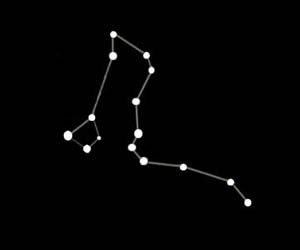Draco Constellation Facts

The serpent like constellation of Draco snakes its way across the night sky
- The Draco constellation never sets below the horizon, as a result it is visible all year in the Northern hemisphere.
- Constellations that don't set are known as circumpolar constellations.
- Draco is one of five circumpolar constellations in the Northern hemisphere.
- The constellation of Draco is only partially visible in some northerly regions of the Southern hemisphere during the winter months.
- Despite being one of the largest constellations it is not particularly noticable in the night sky due to the dimness of most of its stars.
- Draco is Latin for dragon.
- A small galaxy known as the Draco Dwarf exists within the constellation, it's a satellite of our own galaxy, the Milky Way.
- The Cat's Eye Nebula is also situated within the boundaries of the Draco constellation.
- Draco was one of the original constellations catalogued by the Greco-Roman astronomer Ptolemy in the 2nd century.
Draco Mythology

The constellation of Draco is associated with dragons from ancient mythology.
Main Stars in the Draco Constellation

The number next to each star is its apparent magnitude, its brightness from our point of view
on Earth, the lower the number the brighter the star in the night sky.
Also known as Alpha Draconis, Thuban is a white giant star around 300 light years from Earth, it has a mass around 4 times that of sun and a diameter around 7 times greater. Around the period of 4,000 to 2,000 BC Thuban was used by the ancients as the pole star as it was the closest star to the North Pole at that time. Edasich
Also known as Iota Draconis, Edasich is an orange giant star around 100 light years from Earth, it has a mass around twice that of Earth and a diameter around 11 times greater. Aldhibah
Also known as Zeta Draconis, Aldhibah is a blue giant star around 330 light years from Earth, it has a mass around three and a half times that of the sun and a diameter around two and a half times greater. Nodus Secundus
Also known as Delta Draconis, Aldib or Altais, Nodus Secundus is a yellow giant star around 100 light years from Earth, it has a mass around twice that of the sun and a diameter around 11 times greater. Grumium
Grumium is an orange giant star around 112 light years from Earth, it has a similar mass to the sun but is around 12 times larger in diameter. Eltanin
Also known as Gamma Draconis, with a luminosity around 500 times greater than that of the sun Eltanin is the brightest star in the constellation, it is an orange giant around 150 light years from Earth, it has a mass 70% greater than the sun and is around 50 times larger in diameter. Rastaban
Also known as Beta Draconis, despite having a luminosity around 1,00 times greater than that of the sun Rastaban is only the third brightest star in the constellation relative to how we view it on Earth, it is a yellow giant around 380 light years from Earth, it has a mass 6 times greater than the sun and is around 40 times larger in diameter.
Finding Draco - Northern Hemisphere

Finding Draco - Southern Hemisphere
